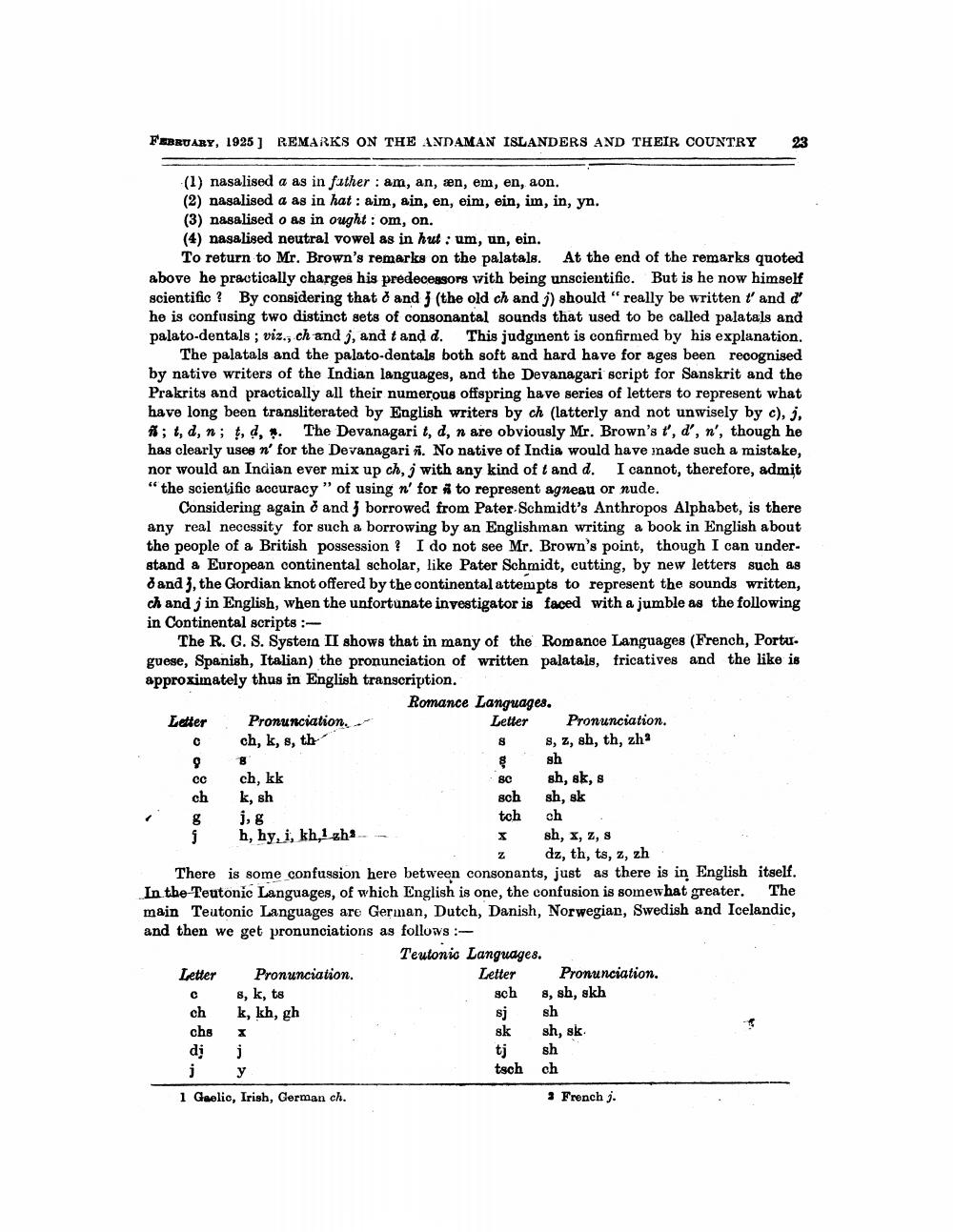________________
FEBRUARY, 1925] REMARKS ON THE ANDAMAN ISLANDERS AND THEIR COUNTRY 23
(1) nasalised a as in father: am, an, æn, em, en, aon.
(2) nasalised a as in hat: aim, ain, en, eim, ein, im, in, yn.
(3) nasalised o as in ought: om, on.
(4) nasalised neutral vowel as in hut: um, un, ein.
To return to Mr. Brown's remarks on the palatals. At the end of the remarks quoted above he practically charges his predecessors with being unscientific. But is he now himself scientific? By considering that & and 3 (the old ch and j) should "really be written and d he is confusing two distinct sets of consonantal sounds that used to be called palatals and palato-dentals; viz., ch and j, and t and d. This judgment is confirmed by his explanation.
The palatals and the palato-dentals both soft and hard have for ages been recognised by native writers of the Indian languages, and the Devanagari script for Sanskrit and the Prakrits and practically all their numerous offspring have series of letters to represent what have long been transliterated by English writers by ch (latterly and not unwisely by c), j, ; t, d, n; t, d, . The Devanagari t, d, n are obviously Mr. Brown's t', d', n', though he has clearly uses n' for the Devanagari ñ. No native of India would have made such a mistake, nor would an Indian ever mix up ch, j with any kind of t and d. I cannot, therefore, admit "the scientific accuracy" of using n' for # to represent agneau or nude.
Considering again & and 3 borrowed from Pater Schmidt's Anthropos Alphabet, is there any real necessity for such a borrowing by an Englishman writing a book in English about the people of a British possession? I do not see Mr. Brown's point, though I can understand a European continental scholar, like Pater Schmidt, cutting, by new letters such as 8 and 3, the Gordian knot offered by the continental attempts to represent the sounds written, ch and j in English, when the unfortunate investigator is faced with a jumble as the following in Continental scripts :
The R. G. S. Systern II shows that in many of the Romance Languages (French, Portu. guese, Spanish, Italian) the pronunciation of written palatals, fricatives and the like is approximately thus in English transcription.
Letter
с
9
cc
ch
Pronunciation.
ch, k, s, th
g
រ
8
ch, kk
k, sh
j, g
h, hy, i, kh,1 zha
Letter
с
ch
chs
dj
j
j
y
1 Gaelic, Irish, German ch.
Pronunciation.
SC
sch
tch
X
Ꮓ
The
There is some confussion here between consonants, just as there is in English itself. In the Teutonic Languages, of which English is one, the confusion is somewhat greater. main Teutonic Languages are German, Dutch, Danish, Norwegian, Swedish and Icelandic, and then we get pronunciations as follows:
Romance Languages.
Letter
8
s, k, ts
k, kh, gh
X
Teutonic Languages.
Letter
sch
sj
sk
Pronunciation.
s, z, sh, th, zha
sh
sh, sk, s
sh, sk
ch
sh, x, z, s
dz, th, ts, z, zh
Pronunciation.
8, sh, skh
sh
sh, sk.
sh
tj
tsch ch
2 French j.




